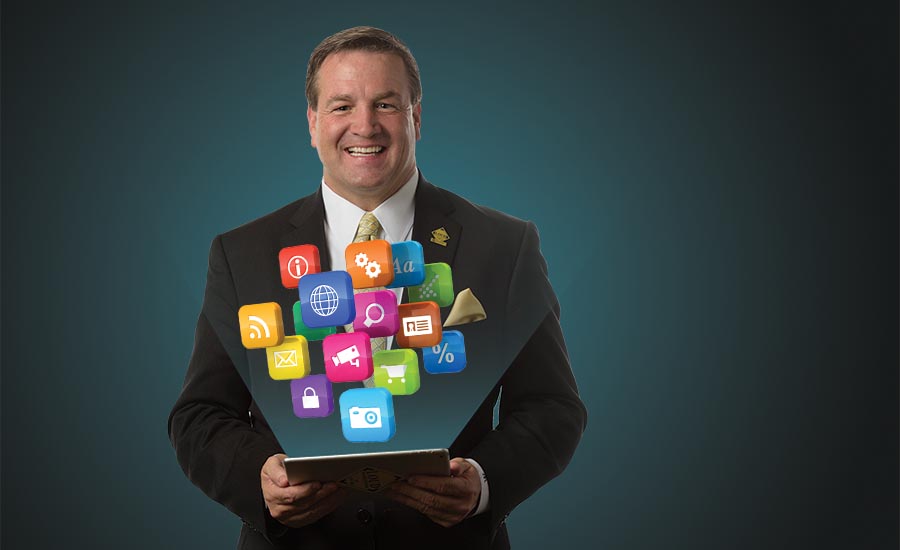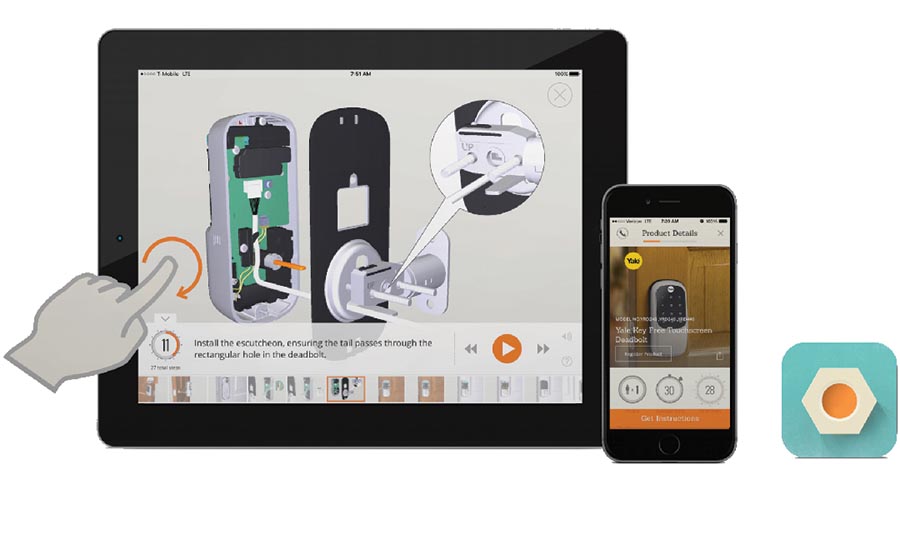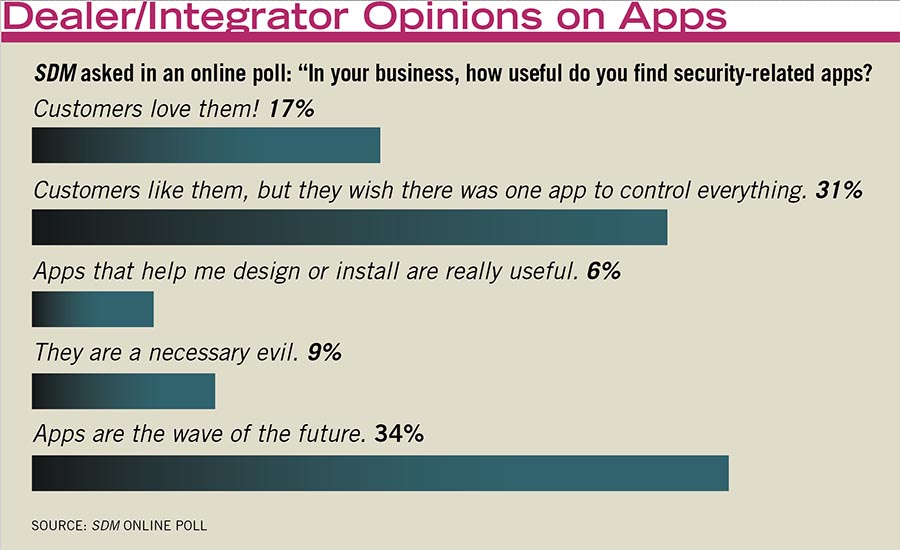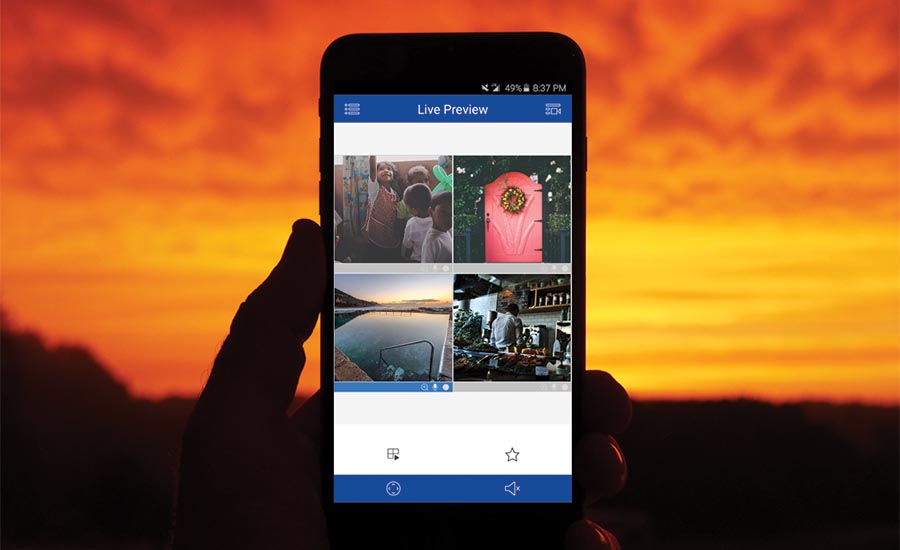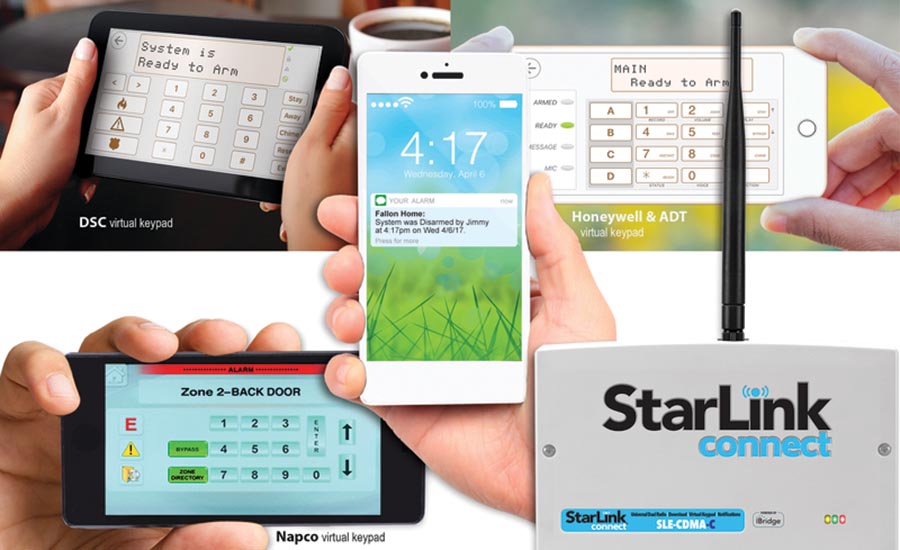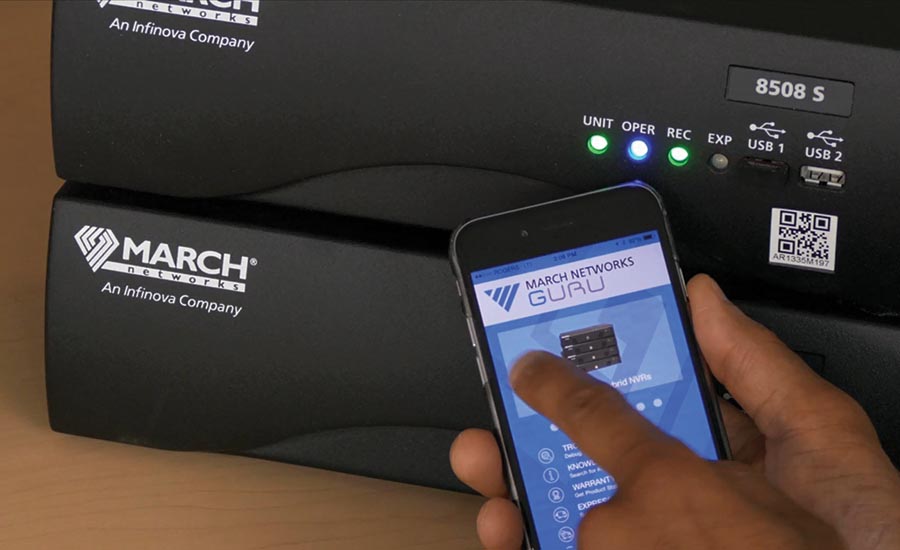Planet of the Apps
Apps are everywhere today, including the security industry. From residential and commercial user apps, to those targeted at helping the channel with sales, service and installation — we take a look at the current and future potential of this ubiquitous technology.

John Loud of LOUD security views apps as a must-have these days, both for end users and, increasingly, for dealers and integrators.

Apps designed to help dealers and integrators design, install and repair are becoming increasingly popular in the security industry. IMAGE COURTESY OF ASSA ABLOY

Dealers and integrators generally view apps as something that is here to stay, but many find customers asking for an integrated app experience.

Video surveillance apps were some of the first to cross over from residential to commercial, as end users realized the value of being able to view video remotely any time or place. PHOTO COURTESY OF ICREALTIME

Napco’s universal StarLink Connect Radios feature app-based remote interactive services for all new or existing DSC, Honeywell, ADT and Napco alarms systems, supporting full smart bus-based data and providing a virtual keypad app that mirrors the actual keypad brand on the wall for dealers’ accounts. PHOTO COURTESY OF NAPCO SECURITY TECHNOLOGIES INC.

Putting QR codes on the front of equipment allows dealers and security integrators to use an app to quickly and easily find a product’s serial number, without having to crawl under racks or disturb anything. PHOTO COURTESY OF MARCH NETWORKS






Wherever you turn today — whether as a consumer, employee, bank patron or business owner — it is almost impossible to avoid using an “app.” You can pay on your phone using an app, deposit a check, play Candy Crush or Words with Friends, purchase items from Amazon and watch videos, to name just a tiny fraction of the more than two million apps available on either Android or iPhone. In the security space, too, apps have found a home, particularly for residential security and connected home users who want to control everything from sound systems and shades to locks and thermostats from their mobile phone.
But within the last few years, the commercial security world has also woken up to the great potential of apps. Initially video surveillance proved a natural fit and one that users quickly demanded. More recently, apps for monitoring, intrusion, fire and access control have been added to the mix.
“At ISC West 2017, the vendor without an app or a mobile strategy was very much the exception rather than the rule,” says Nikhil Shenoy, director of product marketing for Falls Church, Va.-based integrator Kastle Systems. “In fact, many systems and companies are migrating to mobile-first strategies.”
The app trend is not surprising to Sean Murphy, director of regional marketing – video systems, Bosch Security Systems, Fairport, N.Y. “We live in a world in which the majority of people in the U.S. and Canada walk around with a powerful connected computer at their fingertips. Because of that connection, they have developed an expectation that most aspects of personal and professional activities will include that device. In their view, it enhances the experience and delivers higher levels of efficiency, and we strive to make that true.”
Manufacturers of all types of security equipment share that view. “Apps are a natural evolution of the movement toward mobile solutions,” says Bruce Czerwinski, U.S. general sales manager, Aiphone Corp., Redmond, Wash. “People don’t want to be tied to one location to monitor and operate their security systems. Apps are spreading throughout the industry because customers demand them and leading manufacturers are supplying them.”
Most security manufacturers and software providers today believe that apps are a must-have in order to stay in the game.
“We live in a mobile-first world,” says David Kunz, director of product management, Brivo, Bethesda, Md. “User engagement in every industry is through mobile applications; customers expect a mobile experience.” Kunz predicts that by 2020, 20 percent of physical access control solutions will be shaped by mobile and cloud architectures.
“For different aspects of my job I rely on apps every day,” adds Jason Ouellette, senior product line director for access control, Tyco Security Products, part of Johnson Controls, Westford, Mass. “Our industry is starting to get to the same place when it comes to using them for configuration of devices and managing of personnel and devices. When done right it becomes instrumental. I think if our industry is not keeping up and following those trends we would start to see shrinkage and move away from being technology leaders.”
Apps have gone from “cool to have” to “must have” today, says Ryan Zatolokin, senior technologist North America, Axis Communications Inc., Chelmsford, Mass. “In the past people wanted to see video on the phone because it was cool. But today we have found better use-cases for that video. With the cost of false alarms, the ability to verify a video is huge. That makes a real difference.”
Dealer John Loud, president, LOUD Security Systems, Kennesaw, Ga. (featured on this month’s cover), views apps today as an “absolute, vital necessity. Our phone is a full-fledged computer. To have the app now expedites so much of the interactions or transactions. It is vital for any manufacturer of solutions and for having the flexibility to add in those future IoT items to keep the apps current.”
This was certainly a key tenant for Josh Hauser, founder of momanddad.com LLC, New Brighton, Minn., a completely app-based “Building Internet of Things” product. “You have to have an app now to be considered a business that’s larger than the physical space you take up in the consumer’s mind.”
SECURITY APPS FOR END USERS
It’s safe to say that, within the security industry, the residential space is out ahead of the app trend. This is partly a factor of sheer volume, says Jim Coleman, president, Operational Security Systems Inc., Atlanta. “It is expensive to write apps. You have to have a lot of people using it and paying for it before it makes sense. The truth is we are not that big of an industry…. There are just more people on the residential side and it goes into the whole lifestyle thing where you can turn your air conditioning down or arm/disarm the system remotely. The number of people using that gets pretty high.”
In the residential security world, apps are critical to sell any system today. In fact, there are many newer connected security systems that don’t even have panels today — they just use a smartphone.
The Dragonfly residential video app, for example, was designed from the start to be an app-controlled product, says Keith Jentoft, Dragonfly leader and integration team, RSI Video Technologies (now owned by Honeywell Security and Fire), St. Paul, Minn. “There is no keypad. The only control you have of the system is your smartphone…. If you don’t have a smartphone you can’t use Dragonfly.”
Video was the initial crossover for apps into the commercial security world, Zatolokin says. “For remote video, since we got smartphones someone figured out that it would be cool to look at video on them. That was about six years ago. But they have come a long way.”
Some would say they haven’t gone far enough. “I honestly see in the video space just about every company has an app that allows you to view video from the mobile phone; but that is where it stops,” says Dan Cremins, global leader of product management, March Networks, Ottawa, Canada. “You don’t necessarily see something that stands above the rest.”
The commercial video industry has definitely reached the point where apps are essential, but not necessarily differentiating. Security integrators are more likely to lose a bid if the product doesn’t have an app than to win it on the merits of the app. This is different than the residential side, where the app interface is the first thing homeowners want to see, in many cases.
“With respect to the video surveillance industry in residential markets, it’s a must-have,” says Michael Lambert, integration and software development specialist, IC Realtime, Pompano Beach, Fla. “Buyers and consumers are making hardware purchasing decisions based off the performance of the mobile application. Frequently this is the first question asked before even looking at surveillance hardware. Having no app (or a poor one) will prevent a potential customer from even looking at your hardware goods.”
Video hardware and software manufacturers realized early on that apps were going to be important. But they are increasingly realizing there is much more to an app than just having one.
“Everybody raced to get something out that was sort of average,” says Andrew Elvish, vice president of marketing, Genetec, Montreal. “We have seen many apps where you can see all the tiles on the phone and they are more or less better or have more capability.
“We have taken a bigger approach to application,” Elvish says. “We find it gives us the agility to take the best from all of our infrastructure products and recombine them into these very tailored experiences for the customer…. Apps allow you to bring those features forward for the end user and bridge the consumption gap — the difference between the cool things in the product and what people use 90 percent of the time.”
Access control systems more recently got on the app bandwagon, in part as the mobile and cloud trend began to push forward and end users were more interested in allowing remote control of doors and authorizations.
“In January of this year we launched the new version of Pro-Watch, which includes an app,” says Samir Jain, general manager, enterprise solutions, Honeywell Security and Fire, Melville, N.Y. “It is targeted to the end user or administrator. If you have someone locked out of a building that needs immediate access you can do that from the app. Or you can do the opposite and remove access. If you think about buildings where you have hundreds or thousands of people, you need the ability to quickly turn on and off access to different people. Administrators are seldom at their desk.”
This is the theory behind Aiphone’s apps, Czerwinski says. “Aiphone has offered end user apps for almost two years. They provide audio and visual input from our door stations, allow for remote opening of doors, and have paging capabilities.”
Another “app” that is heavily influencing the access control space right now is mobile credentials. “Apps for mobile access control and mobile identity checks have been the most useful in real access control projects,” says Dave Ella, vice president, products and partner programs, AMAG Technology, Torrance, Calif. “However, the big step forward [for us] is new Bluetooth apps for access control because, instead of them being used by a few security employees, they are now available for use by every employee, contractor and visitor to the company.”
As more security technologies get “app’d” that also brings a new challenge or opportunity for both manufacturers and security integrators. “On the residential side … you can say, ‘here is an app for the thermostat and security,’ but cameras may be separate systems [or not],” Jain explains. “The challenge on the commercial side is as an end user, do I have to limit myself to one manufacturer?”
Eric Widener, general manager, LOUD Security Systems, agrees. “Commercially there have been much larger concerns about apps on the network and whether you can keep the security when it comes to cyber threats. (See sidebar, online, website to come.) That has held back app usage. In the past it was limited to viewing cameras; but we are finding now that business owners are allowing us to put an app on their security system to allow principals to arm and disarm the system or for taking control of access and not have the need to be tethered to a full computer station.”
But as the residential world continues to mature into its app usage and the connected home trend advances, the influences on the commercial side regarding apps will likely be great. “When you have access to information at your fingertip, you come to expect it in all aspects of your life including how you manage your video surveillance and access control,” says Melissa Stenger, vice president of product management and marketing, ISONAS Inc., Boulder, Colo. “The pervasiveness of the IoT and consumer-focused brands like Nest are setting expectations for customers and the security industry has to keep up with demands from customers to compete.”
APPS FOR DEALERS & INTEGRATORS
One of the more exciting app trends for dealers, security integrators and installers is an upswing in apps specifically designed to make their work easier. Many video manufacturers, for example, now offer apps to make set-up, troubleshooting and repairs possible from a mobile device.
“To be able to use the phone to focus a camera is a huge advantage,” Zatolokin says. “Coming from the integrator world, there is nothing worse than trying to climb a ladder with a laptop. The idea is the installer can use the phone they carry with them every day to configure that camera on-site. Time is money.”
Integrator Thomas Lienhard, director of business development, Artery Lock Security Integration, Medford, Mass., finds apps like the one from Axis and others very useful. “Axis has a really nice installation tool that … feeds you the view through the camera. When you are finished you dome cover the camera, connect the internal cable, and move on to the next camera. That is a great tool. It used to be you would have to pick up a phone and direct someone to move it left, right, etc.”
March Networks uses QR codes to help dealers and integrators install and service, Cremins says. “If they need to know the serial number they just scan the code on the front. They don’t have to crawl around and look for it.”
Tom Cook, senior vice president of sales, Hanwha Techwin America, New Haven, Conn., calls his company’s device manager app, “the most powerful and useful app that is used on every camera or job with Hanwha cameras.”
Dealers and homeowners alike really appreciate the mobile app Interlogix launched in 2015 to help with programing and setup, says Warren Hill, product marketing leader, intrusion and smart home, Interlogix, a Lincolnton, N.C.-based part of UTC Climate, Controls & Security, a unit of United Technologies Corp. “We also have a dealer portal so they can access that on anything that is connected to the Internet to remotely troubleshoot the panel sitting in someone’s home. Dealers get calls all the time asking, ‘Why isn’t this working?’ They can get on the portal and quickly tell them what is mostly likely wrong and whether they need to send someone out or not.”
A similar feature from EMERgency24, Chicago, lets both the dealer and subscriber put their system into test and view history, says Kevin McCarthy, national sales manager. “For our dealers we developed a mapping feature that shows them all of their accounts around them when they are in any given area,” he adds.
This is a newer trend in the access control space, Ouellette says. “This past year we have really started to see the integrator community asking for the ability to leverage apps as a way for them to do their job.”
ASSA ABLOY’s new BILT application for Apple and Android devices helped the company win a New Product Showcase award this year in the access control devices and peripherals category. The app gives the installer access to fully interactive installation instructions using a voice-narrated, step-by-step guide to help ensure an efficient installation, according to the company.
Honeywell’s integrator-focused apps concentrate on the selling side, Jain says. “The ones you think about in terms of configuring, quoting, spec’ing are more in the infant stages today. We have a few [more] on the fire side for inspections. We are more focused on how we make our integrators more successful in showcasing our solutions.”
These sales tools pull all the potential solutions into a utility to show prospects how that would look, he says.
This is a key feature of Sonitrol’s sales demo app, says Alyssa Wagner, Sonitrol marketing manager, Stanley Security, Indianapolis. “It allows Sonitrol sales reps to demonstrate impact and the verified audio intrusion concept to prospects. Being able to actually ‘hear’ what makes Sonitrol unique has been a key to our sales success.” They also employ QR codes to help techs use their phones to quickly set up systems, she adds.
Security-Net, a network of security integrators, contracted with AppBarry LLC, a software consulting company, to develop an app for its members to communicate with customers and each other in a standardized way, says Joseph Barry, president of the Atlanta-based firm. Security-Net partners can give customers log-ons and they can access the service portal and submit tickets. The app on the technician side lets them know what they have open, their schedule, etc. On the front end, the app allows integrators to do a site survey from their phone or tablet.
Integrator Dave Sweeney, chief operating officer, Advantech Incorporated, Dover, Del., is a member of Security-Net and an avid user of the app. “It gives our entire team the ability to organize information. Prior to this our team members would go out and take a whole bunch of pictures and hope they remembered which were associated with which area of the building. This provides a structured way to collect the same information every time.”
Whether it is this app or others that have started to be offered by manufacturers, Sweeney says it is important to show professionalism and technological savvy. “There is nothing more comical than a guy who shows up selling the next greatest technology, then pulls out a piece of paper and a pencil. Let’s use technology to make a better impression.”
Regardless of the type of app, security integrators and dealers wholeheartedly appreciate the effort. “I think some of the more exciting and encouraging things as a dealer are when manufacturers have an app to help us,” Loud says. “When we start to see the installer be able to use an app to do all the programs, those manufacturer apps are trying to make life easier for dealers and those are big winners for us.”
THE FUTURE OF APPS
A look at the connected home market may give a glimpse into where the commercial security market is headed, although there are clearly differences in approach. The residential world — both for security and for all the technologies it connects to — is almost too full of apps, with more being added every day. When you have individual apps for everything from your security system to your coffee pot, life can get overwhelming in a hurry, which is why companies such as Honeywell, Alarm.com and many others now offer approaches that give the consumers one app to cover everything.
Is “app fatigue” something that could happen across the wider security industry as well? Yes, if things keep going the way they are. But many manufacturers and others have creative visions for where the app trend will end up, and in some cases it may not even have to include a smartphone or tablet.
Note: these numbers may change. In an informal online poll of SDM’s website visitors that asked their opinion on apps, 31 percent of respondents noted that their customers like apps but wish there was one app for everything, while 34 percent agreed that apps are the wave of the future.
Tyco’s Ouellette says his company already offers approximately 35 apps across its product lines — and this number is growing. “In some cases they work together and in others they are independent solutions particular to product lines,” he says. “The need for app consolidation is already starting to happen. We have a total security solution, combining our Kantech EntraPass with DSC intrusion and exacq video that can be managed through a single mobile app. We had customers that were combining and using all three of those, so we responded with an app for that.”
He cautions, however, that there are so many different use-cases in the commercial security world that one-size-fits-all may not always be appropriate. Instead, many access and video manufacturers are turning to the cloud and Web service to achieve a similar effect. “Apps will continue to be a growing trend and very important for us in meeting customer needs; but alongside this, Web services and some of the capabilities of those allow us to drive app-like behaviors.”
Shenoy says his customers, too, are seeking the all-in-one experience. “These comprehensive apps include their own integrations as well as third party applications that, in conjunction with security, provide an enhanced end user experience.”
On the video side, Cremins says future apps will include more functionality. “I think it is going to evolve from being able to see live and recorded video, to being able to apply analytics. That is really coming around. The buzz at ISC West was [artificial intelligence] and deep learning. If you can start applying that technology to something you can get in an app, that is amazing.”
Genetec is already designing apps that are aimed at vertical applications, Elvish says. “It isn’t, ‘Here is our access control system or VMS,’ but instead, ‘Here is our application for your university that pulls together things like communications systems, video, access control, time and attendance, and cafeteria solutions into one experience for that customer.”
An application can be both mobile and traditional, he adds. “Apps are an application of technology to a mobile framework. That is the essence of them. In tailoring the experience of that technology to a specific application in many cases it will be mobile.” In other cases it may even include augmented reality through the phone.
“Our belief is that right now our frame of reference is a phone, but I think it will encompass so much more,” Elvish adds. “It’s about understanding our environment in a very tailored and focused way. That could be through a phone or augmented reality glasses.”
Not surprisingly, Honeywell, one of the leaders in a consolidated app experience on the residential side, is also looking at this for the commercial side. “What is different about where we are going is we try to focus on really strong integrations with our products,” Jain says. “Going forward I expect the notion of integration in a single app and it will be a cloud-based system.”
Definitions may not be the ultimate goal, Jentoft adds. “I don’t think it is about the app itself. I think the service behind the app is most important. Ultimately, I will want those services given to me so I can consume them in the most efficient way…. The service that you are delivering can be packaged to various verticals or specific kinds of markets or applications. But they do want it packaged. The platform is the smartphone and the app is the graphical user interface. Customers are using that phone to touch the services at the other end.”
Sweeney is hoping the app trend continues to evolve and mature for the good of his customers, and the industry as a whole. “Holistically I would like to see the manufacturing community embrace technology down to the application level. We call ourselves technology companies and we typically do some pretty cool stuff to solve customer’s problems with technology. But sometimes that final user touchpoint isn’t up to snuff with the balance of how our customers interact with computers on a daily basis. There is tremendous room for improvement.”
End user demand is not going to slow down, Kunz says. “I think apps have given rise to the mobile security manager and disrupted how security gets handled, as we found that manually monitoring on big screens is ineffective. Mobile applications help to free up time and allow users to become more engaged in other activities. Gone are the days an admin is tasked to manually monitor the security of a business, because with mobile applications you are no longer stuck or confined to a desk.”
What Makes a Good App?
What goes into making and maintaining apps? For many in the industry it has been a steep learning curve to figure out how to optimize the most features and functions on a mobile device without making it too cumbersome or difficult to use.
Apps can’t be just for the tech geeks, says Tyco Security Products’ Jason Ouellette. “From a traditional server/client solution, a mobile app has less bandwidth and a smaller visual area to work with. Learning how to move development around those constraints and make it still functional and intuitive presented a whole new challenge for our team.”
Customers are looking for a good-looking app that is stable, says Thomas Lienhard, Artery Lock Security Integration. “There are millions of apps out there and a lot of them just sort of work, or you have to park other things in the background and the graphics look like Minecraft, and you are wondering what type of developer did that?”
Todd Piett, ENP, chief product officer at Rave Mobile Safety of Framingham, Mass., a company that provides personal safety apps, says apps that are not going to be used daily particularly need to be simple in design. “Our focus first and foremost is on simplicity of use during a stressful situation. During an emergency usability is critical and you can’t depend on a unique process being remembered.”
Genetec recently white labeled some apps in a collaboration for a smart office, says Andrew Elvish. “[That process] teaches you a lot about what commercial end users are going to be expecting. These were not security professionals. It really got us thinking about what this experience is like.
“I think the No. 1 thing is to not think about the app as just your desktop application running in a slightly less performant way on a small screen. That is the kiss of death,” Elvish says.
With limited space to work with, having an app is a bit like having a tiny apartment and buying a new piece of furniture — you have to figure out where to put the old furniture without making it too cluttered, says March Networks’ Dan Cremins. “As we cram more functionality within the app, you don’t have the room you have on the desktop. How do I add more functionality without making the interface more complex? Every time we add functionality we also streamline the interface.”
And adding functionality is expected — frequently. “Apps are more like the cloud,” Elvish says. “People expect their app to update frequently with new and delightful things. It cannot be static.” Genetec strives to release something every week-and-a-half to two weeks, he says. “It is not typical in our industry to update that frequently.”
This comes as a surprise to many in the security industry, says Honeywell’s Samir Jain. “I don’t think we knew on day one that development doesn’t stop after six months. When you talk about making an app it is a permanent investment to continue to enhance and keep features fresh. It is not a one-time thing, which is significantly different from what we have traditionally done.”
Joseph Barry, president of AppBarry LLC, the software company that developed an app for Security-Net, says his company works on two-week “sprints.” As soon as one update goes out, they meet to figure out what to do next, he says.
Should You Develop an App?
So far the majority of apps in the security world have come from manufacturers and large organizations. They are complicated, expensive and require ongoing care, so their development isn’t for the faint of heart. Still there are some dealers or integrators that have done it, and there may be more in the future who see a reason to try.
“Integrators that offer additional services or want to focus on specific needs of a market have created their own apps, says Bosch’s Sean Murphy.
Kastle Systems is one such integrator. The company introduced its IoT platform app in January 2016, says Nikhil Shenoy. “It includes a hands-free access control, a personal mobile panic button, notifications, location awareness and a growing suite of security and building-oriented features and integrations.” The company’s MyKastle app, which enables customers to unlock and lock doors remotely, is another offering.
LOUD Security, too developed its own app, says John Loud. Eric Widner, general manager at LOUD, was in charge of the app. “Ours ended up being a failure,” he says. “When we released it the goal was to bring stickiness to the relationship between us and our end users and to give them one place to come to LOUD and get anything they might want from us. They could set an appointment, get to social websites, get any contact information, contact billing, etc.”
Like many manufacturers report, however, there is a steep learning curve to apps, as Widner found out. “I believe it was a failure because we were relying too much on third-party apps to actually do the rest of the backbone of the infrastructure. They couldn’t do interactive services through the app. It wasn’t a smooth transition. For online bill pay you couldn’t do it from the app; it would launch a webpage. I believe people lost interest because they couldn’t do everything they needed to.”
Thomas Lienhard of Artery Lock Security Integration, says his company developed an app, but on the AV side of the business. “Clients can swipe up to begin a presentation, for example. Writing apps that do these types of things streamlines things.” He adds that they aren’t currently doing any security apps, but would like to.
As for Widner, he says LOUD doesn’t have any immediate plans to try again but they will likely try it in the future. “Long-term I would love to, but only if I can find a way to unify everything under our brand.”
That may be coming soon, in a way, says Honeywell’s Samir Jain. “If I am a dealer or integrator, how do I take that Honeywell app and somewhat start to brand it mine? We haven’t done it yet, but we have started to do this with webpages. We will give you the landing page and give the integrators the ability to customize the headers, the title, the branding or co-branding. I can easily see opportunity in the future [with apps]. It’s something we haven’t done today but are looking at.”
Looking for a reprint of this article?
From high-res PDFs to custom plaques, order your copy today!






